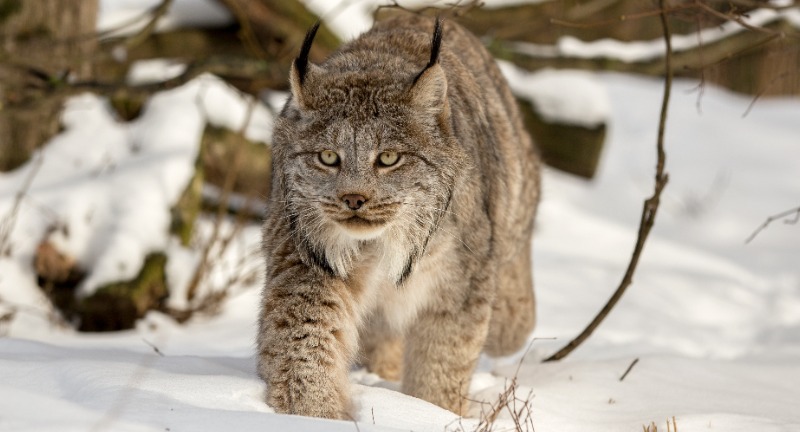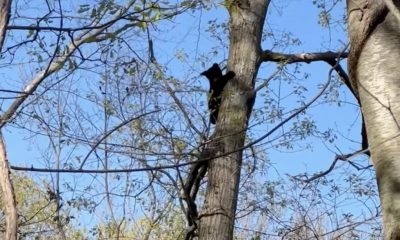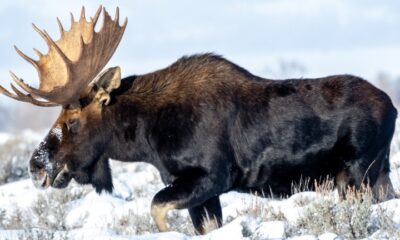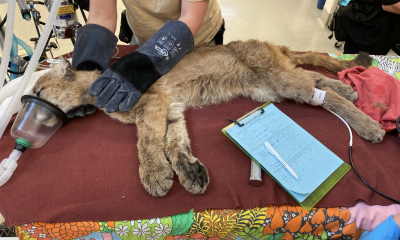NEWS
17 States with Thriving Lynx Populations
Published
3 months agoon

Shutterstock
The elusive lynx, with its tufted ears and piercing gaze, roams the wilderness of North America like a shadow. These secretive cats thrive in specific regions, blending seamlessly into dense forests and snowy landscapes.
While their presence might seem rare, knowing where to look, or where they thrive can bring you closer to these fascinating creatures. Discover the states where lynxes still roam wild and free, preserving their place throughout America.
Alaska

Shutterstock
Alaska is a haven for lynxes, offering expansive wilderness and rich boreal forests teeming with snowshoe hares. These cats are well-adapted to the harsh winters, with large, furry paws that act like snowshoes. Sightings are more common in remote areas like the Tongass National Forest and Denali National Park. The lynx population here is robust, thanks to the pristine habitats and limited human interference.
Montana

Shutterstock
Montana’s mountainous terrain and dense forests provide excellent habitats for lynxes. The Bob Marshall Wilderness Complex is a hotspot for sightings, with populations thriving due to abundant prey. Winters can be brutal, but the lynx’s thick fur and stealthy hunting techniques make survival possible. Conservation efforts in Montana have focused on preserving critical habitats and monitoring lynx populations.
Colorado

Shutterstock
Colorado’s reintroduction programs have been instrumental in reviving the lynx population in the state. The San Juan Mountains are particularly known for successful rewilding efforts. Snowshoe hare populations support these predators, and sightings have become more frequent since the early 2000s. Colorado serves as a testament to how conservation initiatives can restore balance to ecosystems.
Maine

Shutterstock
Maine is one of the best states for observing lynxes in their natural habitat, particularly in northern forests. With vast tracts of boreal forest and a healthy population of hares, the state is ideal for these elusive cats. Winter is their prime hunting season, as their specialized paws allow them to navigate snow with ease. Lynx populations here are monitored closely to ensure sustainable numbers amid logging activities.
Minnesota

Shutterstock
The northern forests of Minnesota, particularly in areas like the Superior National Forest, are a stronghold for lynxes. Here, the snowshoe hare population is a critical food source, making the state a key habitat for these felines. The state experiences harsh winters, but lynxes are perfectly adapted to the cold. Minnesota also supports research and conservation projects to better understand and protect these animals.
Washington

Shutterstock
Lynxes are known to inhabit the Cascade Mountains in Washington, taking advantage of the dense forests and rugged terrain. Their presence in the state is sparse, but ongoing conservation efforts aim to expand their range. Lynx populations here are threatened by habitat fragmentation and competition with other predators. Still, sightings in the Okanogan Highlands show promise for their survival.
Idaho

Shutterstock
The rugged wilderness of Idaho, particularly near the Canadian border, is home to small but stable lynx populations. The Selkirk and Bitterroot mountain ranges offer ideal conditions for these elusive cats. Lynxes are often spotted during the winter months when they are more active and visible. Idaho’s conservation efforts include monitoring habitat changes due to climate and human activity.
Wyoming

Shutterstock
Wyoming’s wild landscapes, including parts of Yellowstone National Park, are home to lynxes. These cats favor higher elevations where snow cover lasts longer, giving them an edge in hunting snowshoe hares. Wyoming’s conservation strategies have included habitat preservation and the protection of lynx migration corridors. Sightings remain rare, highlighting the lynx’s secretive nature.
Oregon

Shutterstock
Lynxes in Oregon are primarily found in the eastern and northeastern parts of the state, particularly near the Blue Mountains. Their numbers are relatively low but stable, thanks to remote, forested areas that minimize human interaction. Conservationists are focused on protecting these areas from logging and other habitat disruptions. Sightings are most likely during the winter months when they are on the hunt.
Vermont

Shutterstock
Vermont’s boreal forests and mountainous terrain make it a potential home for lynxes. The Green Mountains are a prime area where these stealthy cats may roam. Though sightings are rare, lynx populations are believed to be gradually increasing. Efforts in Vermont include creating wildlife corridors to facilitate lynx movement across fragmented landscapes.
New Hampshire

Shutterstock
Lynxes are known to inhabit the northern forests of New Hampshire, particularly near the White Mountain National Forest. These cats thrive in areas with abundant snowshoe hares and minimal human disturbance. Sightings are infrequent but increasing, thanks to habitat conservation. Winter surveys often reveal their tracks, a testament to their growing presence in the region.
Michigan

Shutterstock
Michigan’s Upper Peninsula offers a suitable environment for lynxes, with dense forests and abundant prey. While sightings are sporadic, tracks and signs suggest a small but persistent population. The state’s conservation programs focus on protecting critical habitats and monitoring potential migration from Canada. Harsh winters give lynxes an advantage over less-adapted predators.
Wisconsin

Shutterstock
In Wisconsin, lynxes are occasionally spotted in the northern forests bordering Minnesota and Michigan. Their elusive nature makes them difficult to track, but evidence points to their presence in remote areas. Conservationists emphasize the importance of protecting these regions from deforestation and development. Wisconsin’s winters create a perfect backdrop for the lynx’s snowy camouflage.
Utah

Shutterstock
Lynxes in Utah are primarily found in the Uinta and Wasatch Mountain ranges. These areas offer high-altitude forests and abundant snowshoe hares, crucial for their survival. The state has implemented wildlife monitoring programs to study lynx movement and behavior. Sightings remain rare but highlight the resilience of these adaptable predators.
Nevada

Shutterstock
The mountainous regions of northern Nevada occasionally host lynxes, though sightings are extremely rare. Their range here overlaps with prey-rich areas near the border with Idaho and Oregon. Conservation programs aim to ensure these habitats remain intact for potential population growth. Nevada’s wild and remote terrain makes it an intriguing, if challenging, environment for these cats.
North Dakota

Shutterstock
Lynxes have been documented in the forested regions of North Dakota near the Canadian border. Their presence is linked to the migration of snowshoe hares and other prey species. Conservationists in North Dakota work to ensure that critical habitats remain undisturbed by agricultural expansion. Harsh winters and remote landscapes provide a safe haven for this elusive predator.
New York

Shutterstock
In New York, lynxes are sometimes spotted in the Adirondack Mountains, a region with ample prey and dense forests. Their population remains small, but signs of their presence are increasingly documented. Conservation initiatives focus on maintaining the integrity of the Adirondack wilderness. Winter tracking surveys reveal the persistence of these elusive cats in the region.
Conclusion

Shutterstock
The presence of lynxes in the wild is a testament to the resilience of nature and the importance of conservation efforts. By protecting their habitats and understanding their role in the ecosystem, we ensure these majestic creatures continue to roam freely. Whether you’re an avid wildlife enthusiast or simply captivated by their beauty, knowing where lynxes thrive deepens our connection to the natural world. As stewards of the environment, it’s up to us to safeguard the wilderness these cats call home for generations to come.
More Amazing Animals+
-


25 Reasons to Choose the Chow Chow as Your Pet
-


Orphaned bear cubs playing in tree after mother bear, Bobbi,…
-


25 Reasons French Bulldogs Are Hugely Popular
-


Alligator arrest outside of a school in Charleston, SC
-


25 Reasons Why Border Terriers Are the Ultimate Small Dog…
-


Eyes of the Night: 20 Incredible Facts About the Great…
-


A Woman Recieves a Surprise Gift in the Air After…
-


Baby otter hugs and snuggles mom
-


21 Wild and Wonderful Facts About the Mighty Moose
-


Roaming Mountain Lion Rescued From a Classroom in California
-


25 Reasons To Love Scottish Terriers
-


25 Fun Facts About Irish Setters That Will Surprise You
